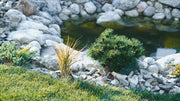
You spent weeks shaping perfect curves, folding EPDM with surgical care—then the sun came out and that shiny black band glared at you from every angle. A visible liner edge yanks the eye away from waterlilies and koi, shouting “I’m man-made!”. Luckily, disguising that edge (and keeping coping stones rock-solid for years) is easier than you might think. Follow the field-tested ideas below and your guests will search in vain for the liner while admiring a Poposoap solar fountain dancing at center stage.
Introduction: Why Liner Visibility Ruins a Natural Look
A pond should blend into its surroundings like a woodland pool—water meeting stone, stone fading into plants. Exposed liner reflects light, catches leaf litter, and heats surface water. Worse, UV slowly chalks and brittles uncovered membranes. Hiding the edge not only perfects aesthetics; it protects your investment.
Popular Ways to Hide Pond Liner Edges
1. Stacked Flagstones

Pros: Instant “quarry” vibe, heavy enough to grip liner.
How-to: Dig a 5 cm trench behind the liner, fold excess up and back, then seat the first stone partly below water. Stack two or three courses with a 1 cm inward tilt. Cap with a flat coping stone that overhangs the water 2–3 cm.
2. Pebble Beach & Gravel Shelf

Perfect for small ponds or child-friendly edges. Lay a 20 cm-wide, 10 cm-deep shelf just under the waterline, then spread rounded gravel over the liner. Water hides the shelf; plants creep between pebbles.
3. Berm + Planting Mix

Roll excess liner back under itself, cover with subsoil, then top with rich topsoil. Plant creeping jenny, dwarf mondo grass, or sweet flag. In a month, the liner is a memory.
4. Rock-on-a-Roll or Faux Stone Mats

Lightweight textured sheets glue directly to liner with pond-safe sealant—great where hauling real stone isn’t practical.
5. Driftwood & Bark Slabs

Ideal for rustic wildlife ponds. Anchor pieces with masonry screws into hidden concrete pads so spring ice can’t shove them aside.
Securing Top Stones: Prevent Shifting or Slipping

A perfect disguise falls apart if a heavy flagstone tumbles into the pond. Combine these techniques:
- Hidden L-Shelf. When you dig, cut a 5-cm-deep ledge 15 cm back from the rim. The liner follows that contour, and the first stone sits on the shelf, locked by earth behind it.
- Polyurethane Pond Foam. After stacking, inject black waterfall foam into gaps. It cures flexible, bonding stones without visible mortar lines.
- Geogrid or Landscape Fabric Strips. Lay 10 cm-wide strips over liner, under the first stone course, and back into soil. Weight from backfill grips the fabric, clamping stones downward.
- Stainless Pins. Drill 6 mm holes in neighboring stones and tap in 8 cm stainless rods— invisible dowels that stop lateral creep.
Remember: leave one removable stone or hinged grate for access to your Poposoap solar pond filter’s pre-filter pads. Routine rinses stay easy, liner stays hidden.
Design Tricks for a Natural Finish

- Break Up Symmetry. Alternate stone sizes; tuck one partly under another. Nature hates straight runs.
- Overlay Plants and Hardscape. Position a dwarf waterfall spillway from Poposoap behind rocks; moving water draws eyes to sparkle, away from any minor liner reveal. Their 8-inch spillway pairs with 10- to 20-watt solar pumps—no cables across the lawn.Poposoap Product Manual…
- Color Harmony. Pick local stone shades to echo surrounding soil or patio pavers so coping doesn’t pop out as an afterthought.
- Shadow Lines. Slight overhangs cast a perch-dark line on the water, concealing the vertical liner face even if glass-clear.
Long-Term Maintenance Tips
- Inspect edges every spring for freeze-thaw heave; reset any shifted stone before root growth locks it in place.
- Trim encroaching roots—aggressive willows can burrow behind liner and lift rocks.
- Re-foam tiny gaps when you winterize the pump; polyurethane weathers about five seasons before spot repairs.
- Brush algae from coping stone undersides to stop capillary wicking that stains patios.
Common Mistakes to Avoid
- Starting Stones Above Waterline. Always seat the first layer slightly submerged; otherwise liner shows the moment the pond evaporates five centimeters.
- Folding Liner Under Stone Without Cushion. Weight + grit can puncture the fold. Slide a scrap of underlayment between.
- Using Mortar Alone. Rigid cement cracks under frost; combine with foam or geogrid for flexibility.
- Ignoring Access. Bury all edges and you’ll curse yourself next month when the pump needs cleaning. Plan a disguised hatch.
- Skimping on Plant Coverage. Even the best stone work benefits from creeping foliage draping seams.
Conclusion: Disappear the Liner, Elevate the Look
Mastering liner concealment is the final brushstroke that transforms “nice pond kit” into “I-can’t-believe-you-built-this.” Stack flagstone, sculpt gravel, weave plants, and lock it all down with smart foam and hidden shelves. Add a Poposoap solar fountain or spillway for motion and white-noise serenity, and the eyes (and ears) of every visitor will travel exactly where you want—across glistening water, not along an exposed rubber edge.
When friends ask how to hide pond liner edges or how to cover a pond liner, share these tricks and watch their gardens level-up, too. Because nothing elevates a backyard sanctuary faster than erasing the line between crafted and natural—and now you know precisely how to do it.







